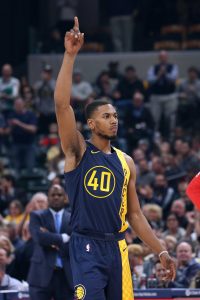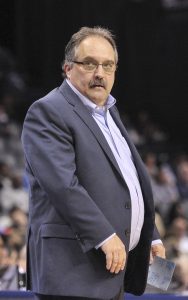Hoops Rumors is breaking down the 2018 offseason for all 30 NBA teams, revisiting the summer’s free agent signings, trades, draft picks, departures, and more. We’ll evaluate each team’s moves from the last several months and look ahead to what the 2018/19 season holds for all 30 franchises. Today, we’re focusing on the Detroit Pistons.
Signings:
- Standard contracts:
- Glenn Robinson III: Two years, $8.35MM. Second-year team option. Signed using mid-level exception.
- Jose Calderon: One year, minimum salary. Signed using minimum salary exception.
- Zaza Pachulia: One year, minimum salary. Signed using minimum salary exception.
- Two-way contracts:
- Non-guaranteed camp contracts:
- Johnny Hamilton: One year, minimum salary.
- Zach Lofton: One year, minimum salary.
Trades:
- Acquired the draft rights to Khyri Thomas (No. 38 pick) from the Sixers in exchange for the Pistons’ 2021 second-round pick and the Pistons’ 2023 second-round pick.
Draft picks:
- 2-38: Khyri Thomas — Signed to three-year, minimum salary contract. First two years guaranteed. Signed using mid-level exception.
- 2-42: Bruce Brown — Signed to three-year, minimum salary contract. First two years guaranteed. Signed using mid-level exception.
Departing players:
- Dwight Buycks (waived)
- James Ennis
- Kay Felder (two-way)
- Eric Moreland (waived)
- Jameer Nelson
- Anthony Tolliver
Other offseason news:
- Hired Dwane Casey as head coach to replace Stan Van Gundy; hired Sidney Lowe as lead assistant.
- Hired Ed Stefanski as senior advisor (and de facto head of basketball operations) to replace Van Gundy.
- Parted ways with GM Jeff Bower.
- Hired Malik Rose and Sachin Gupta as assistant GMs.
Salary cap situation:
- Remained over the cap.
- Carrying approximately $123.3MM in guaranteed salaries, slightly below $123.7MM tax line.
- Hard-capped at $129.82MM.
- $2.89MM of mid-level exception still available ($5.75MM used on Glenn Robinson III, Khyri Thomas, and Bruce Brown).
Check out the Detroit Pistons’ full roster and depth chart at RosterResource.com.
Story of the summer:
The decision got dragged out but eventually owner Tom Gores decided to relieve Stan Van Gundy of his duties as both head coach and president of basketball operations after the season. Van Gundy’s heart-on-his-sleeve approach gave the franchise an initial jolt and the team made the playoffs during his second season in charge. He couldn’t build upon that improvement, as injuries and bad personnel decisions found the Pistons sitting out the postseason the past two years.
Fortunately for Gores, the league’s Coach of the Year became available at just the right time. Toronto fired Dwane Casey after its playoff flop against Cleveland and the Pistons gladly scooped him up. Casey’s reputation as a players’ coach adept at developing young players and winning regular-season games fits what the team needs. They desperately want to get back to the playoffs and start drawing more fans at Little Caesars Arena, which opened last season in downtown Detroit.
The front office underwent a makeover with well-traveled Ed Stefanski sitting atop the organization’s ladder despite the title of senior adviser. The former Grizzlies, 76ers, Raptors and Nets executive hired Sachin Gupta and Malik Rose as assistant GMs but Stefanski is in charge of personnel moves. With the team’s cap issues, Stefanski couldn’t make much of an imprint on the roster this summer anyway.
Key offseason losses:
All of the Pistons’ core players were locked into deals through this season, for better or worse, so they didn’t suffer any significant losses in free agency. The biggest contributor from last season who didn’t return was backup power forward Anthony Tolliver, who averaged 8.9 PPG and shot a healthy 43.6% from long range. He also added a veteran presence to a mostly youthful locker room. Tolliver signed with the Timberwolves but the Pistons plan to replace his minutes with a combination of 2016 first-rounder Henry Ellenson and Jon Leuer, who missed most of last season with an ankle injury.
Eric Moreland received rotation minutes at times at center with the versatile Leuer sidelined but his offensive limitations led the new regime to waive him. Moreland remained a free agent until he signed a camp deal with the Raptors this week.
Early February acquisitions James Ennis and Jameer Nelson didn’t make much of an impact and Dwight Buycks was only used at the point out of desperation. Detroit had no interest in retaining any of those players.
Key offseason additions:
The Pistons went bargain shopping in July to fill out their bench. Casey called Glenn Robinson III one minute into the free agency period and Robinson agreed to a two-year deal before the sun came up the next morning. The low-cost flier on Robinson could pay dividends if he’s fully recovered from the ankle injury that wrecked his final season with the Pacers. Robinson, the former University of Michigan standout, is the type of 3-and-D wing that teams increasingly covet and he should jump right into the shooting guard/small forward rotation that includes Reggie Bullock, Stanley Johnson and Luke Kennard.
Jose Calderon and Zaza Pachulia could contribute more in the locker room than on the court. Casey wanted a couple more veteran voices in the locker room with a track record of success in the league, especially with the loss of Tolliver. Calderon, who played for Casey in Toronto, projects as the team’s No. 3 point guard behind Reggie Jackson and Ish Smith, though Kennard could also see minutes at that spot. Calderon provides some protection if Jackson’s injury woes continue.
Pachulia won rings with the Warriors the past two seasons. The 34-year-old could see some backup duty behind Andre Drummond, though Blake Griffin and Leuer will also soak up some minutes there.
Detroit didn’t have a first-round pick, courtesy of the Griffin trade with the Clippers in late January, but it added two shooting guards in the second round. The brass thought enough of Khyri Thomas to swing a trade with the Sixers to move up and nab him. Thomas and Bruce Brown will probably spend most of the season in the G League, though one of them could get rotation minutes if an injury strikes.
Outlook for 2018/19:
Casey did a splendid job of utilizing his roster and building a quality second unit in Toronto and it’s expected he’ll do the same in Detroit. What he needs most this season is to avoid making changes to that unit due to injuries in the starting lineup.
Griffin and Jackson simply haven’t been able to stay on the court in recent seasons. Griffin has played anywhere from 35 to 67 games over the past four seasons; Jackson has missed a combined 67 games over the last two seasons.
If Griffin, Jackson and Drummond can stay reasonably healthy, the Pistons have no excuse to miss the postseason again. Griffin may not be as explosive as he was before left knee injuries set in but he’s still an all-around force with an improving 3-point shot. Drummond is the league’s best rebounder and even became a passable free throw shooter last season. Jackson can be a dynamo in pick-and-rolls with both big men and he’s developed a reputation as being a clutch performer.
While small lineups are all the rage, having two All-Star level talents in the frontcourt for a full season should be enough for the Pistons to snare a playoff berth in the watered down Eastern Conference. But a significant injury to any of the Big Three would spell doom, since there’s no other impact players on the roster.
Salary information from Basketball Insiders was used in the creation of this post. Photos courtesy of USA Today Sports Images. Luke Adams contributed to this post.
Agreed, is all about Blake & Drummond. Nothing else matters, really.
Agree? “But a significant injury to any of the Big Three would spell doom…”
Jackson is the most crucial, due to Griffin & Drummond being able to cover for each other on the frontline if necessary.
I like Bullock & Dennard on the wings for shooting, but there is nobody else in the backcourt like Jackson. (Maybe Griffin likes it that way?– He likes playing point forward.)